Origins Story
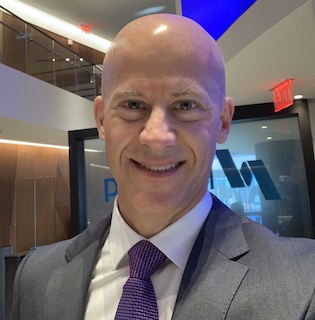 Hello, this is James Gray, and thank you for stopping by this site. I originally started this blog in 2008 to capture ideas of a passion and journey I never intended.
Hello, this is James Gray, and thank you for stopping by this site. I originally started this blog in 2008 to capture ideas of a passion and journey I never intended.
We all have a story that motivates us to pursue a direction. This story encapsulates my mission to help people become a master strategist of their career.
The career path we choose is the single most important decision in our life. It will impact our success, wealth, the people we come in contact with, and ultimately our happiness.
We are given a slice of time on this earth and how we manage the journey each day will influence the experience of our professional and personal life. Achieving and sustaining mastery to remain relevant in an ever-changing world requires commitment.
I hypothesize that adopting a process with a set of proven strategies will increase the likelihood we will live the life we wish for. I help people learn and apply a collection of strategies that help them transition to a unique path designed in context to who they are.
The background below provides the context of why I write and openly share content and work with people directly in a coaching engagement.
The Career Strategist at Microsoft
In 2006 as I evaluated a career change, I realized how challenging it was to decide what path was best for your career and personal life. I was married with children and had high aspirations of achievement. Graduate business studies at the Haas School of Business (University of California, Berkeley) had ingrained a deep sense of strategy into my thinking. It became clear that the principles of strategy and deep experience in product management could be applied to careers. For example, to make choices about paths and how to take the product of “you” to market. I sketched the foundation of a framework to capture this thinking and joined Microsoft in the fall of 2006.
As a leader at Microsoft, I had the responsibility of developing talent within my organization. I was searching for a cookbook and ideas that could guide highly talented professionals through a process to develop and manage a personalized career strategy. I saw a need for strategically managing your career but also crafting one that integrated into one’s broader life. This was the motivation to officially author what I called the “Career Strategy Framework“.
I shared the framework with my small team and we began using it as a process for career discussions. We both benefited from a strategic process that delivered results – business impact and personal career growth. As members of my team transitioned on to new roles within the company, I received feedback from other managers on how these professionals were in control of their careers and clear on what they wanted from the next role.
My intrigue in developing people led to hiring and mentoring new hires that were part of an 18-month rotational program inside of Microsoft IT. I soon became a frequent speaker in the program and a resource to these young professionals. I saw the virtues of sharing this framework beyond my team. I could also feel the mojo anytime I had an opportunity to practice the framework and mentor people. I had never felt anything quite like this before.
One day, I had a 1:1 meeting to get to know the general manager I had been re-organized under. As I stood in the doorway about to leave, I said if there was an opportunity to support the organization’s career process that I would be interested to help. I followed up with an overview of the framework. I was amazed when he came back with an offer to run an experiment. I was granted an opportunity to run a workshop for anybody in the organization that was interested. Ten people signed up and throughout a few sessions, we walked through the 7 principles and how to use them. At first, I was nervous, but I became energized by helping others gain a deeper insight into who they were and how to architect a path they controlled. It was an experiment that changed me and the people that attended. People became more confident in who they were. You could see the sense of excitement as people got up in front of the group and presented their path and plan.
I will never forget one woman from the group who visited my office one day. She said, “I now know what I want to do, I am leaving Microsoft”. She described how she was scared about change and had an urge to pursue a new direction. The quiet, reserved woman had thought deeply about life and knew that it was the ideal time in her life to pursue what was calling her. She and her husband moved to the Bay Area to pursue a new career.
Over the next few years, I found myself speaking at events and sharing my content at any opportunity I got. It was something that took on a life of its own and going places I never intended. The framework began to spread across Microsoft and I was asked to present at the Women’s Global Conference in October 2013. Over 2,000 women attend this event to share ideas and success stories for achieving growth and career success at the company.
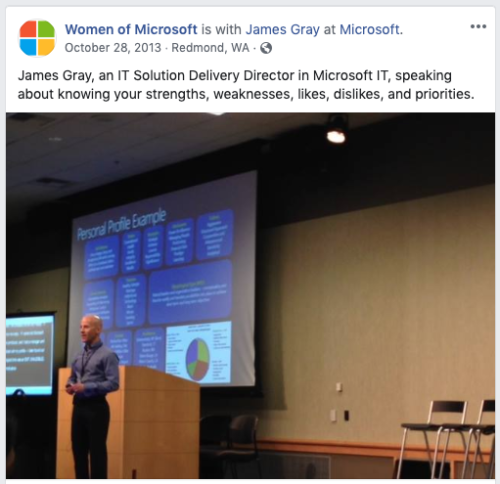 As I took the stage and looked out into an audience of over 800 women, the sight was energizing and unique. After I presented my content and answered questions, I made my way to the conference room lobby that was bustling with hundreds of women.
As I took the stage and looked out into an audience of over 800 women, the sight was energizing and unique. After I presented my content and answered questions, I made my way to the conference room lobby that was bustling with hundreds of women.
Shortly thereafter, a woman stopped by and introduced herself. She told me that she had heard me speak about six months ago at an event. Her eyes began to tear up as she looked down at the floor. I could not imagine what she was going to say next.
She said it was that event that inspired her to change her life. In fact, she thanked me for helping save her life.
October 23, 2013, changed my life forever, as there would be nothing more valuable as a mission in life than helping others.
I knew right then that I would continue this journey after I left Microsoft.
Sometimes we go through life without understanding our impact until others share it with you. I saved the email she sent me a week later as it captures the words she shared with me that day.
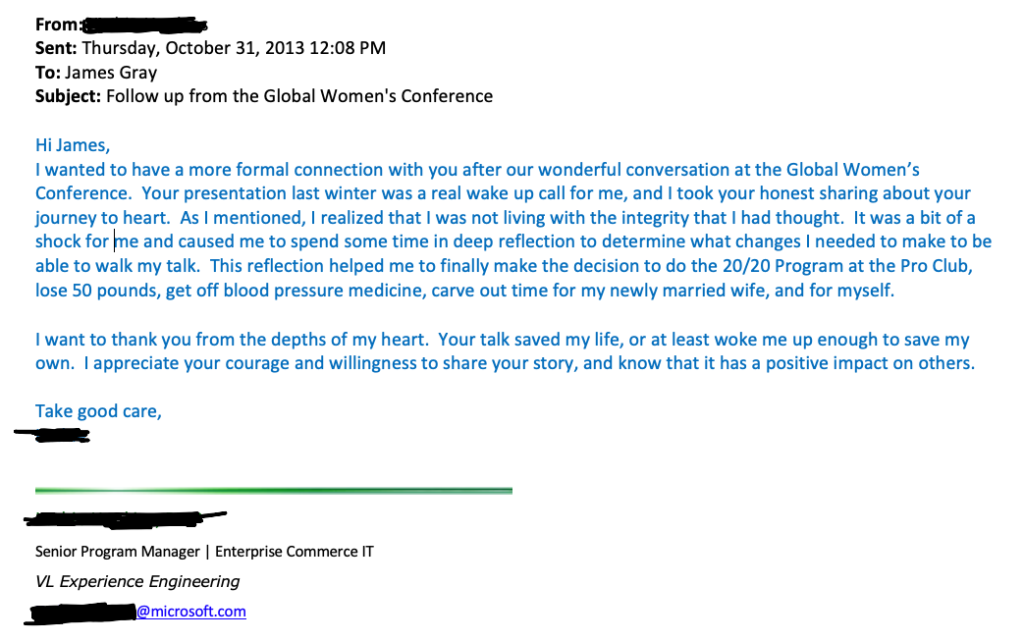
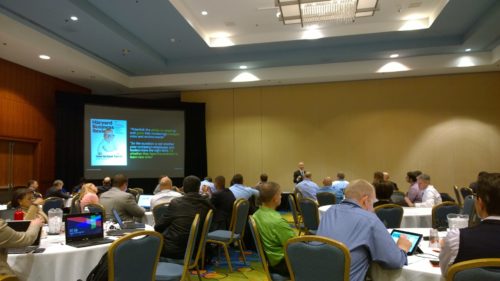 After speaking at an event one day in 2014, I made my way to a cafe inside of Microsoft. Shortly after sitting down, a colleague who attended stopped by and asked me if I would be interested in sharing the framework with an organization that formally develops talent within his division. He went on to say that the framework is exactly what they need to formalize the end-to-end career strategy process. This led me to speak at those program events and helping people prepare to tell their 10-minute story in front of executives. I was having the time of my life and it had nothing to do with my “day” job as an IT leader.
After speaking at an event one day in 2014, I made my way to a cafe inside of Microsoft. Shortly after sitting down, a colleague who attended stopped by and asked me if I would be interested in sharing the framework with an organization that formally develops talent within his division. He went on to say that the framework is exactly what they need to formalize the end-to-end career strategy process. This led me to speak at those program events and helping people prepare to tell their 10-minute story in front of executives. I was having the time of my life and it had nothing to do with my “day” job as an IT leader.
One last story of why I am on this mission. I was asked to speak at a lunch networking and career event for women. The woman who organized the event told me that she forced her husband to also attend. Although I did not meet him at the event, a few days later he sent me an email with an attachment of a few slides that synthesized his career plan based on the example I shared at the event. I was truly blown away. We then met in person and he shared how this helped him.
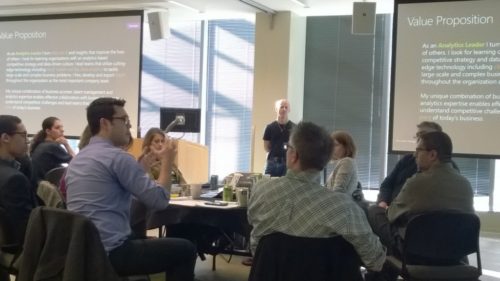 A few weeks later, his general manager asked me to speak at an upcoming event to challenge his organization to do what this young man did. This was incredible as I had never spoken to the GM before the event. At the end of a 2-hour workshop, he asked this man to stand up in front of 100+ of his colleagues. The GM explained how the career plan that was described in a few slides had elevated and changed the dynamic of their discussion and relationship. There was no guesswork on what the employee wanted. The focus was on how the leader could help him achieve his aspirations while delivering impact while he was a member of his organization. I was amazed by the charisma of this leader. People followed him throughout Microsoft as he transitioned into other roles.
A few weeks later, his general manager asked me to speak at an upcoming event to challenge his organization to do what this young man did. This was incredible as I had never spoken to the GM before the event. At the end of a 2-hour workshop, he asked this man to stand up in front of 100+ of his colleagues. The GM explained how the career plan that was described in a few slides had elevated and changed the dynamic of their discussion and relationship. There was no guesswork on what the employee wanted. The focus was on how the leader could help him achieve his aspirations while delivering impact while he was a member of his organization. I was amazed by the charisma of this leader. People followed him throughout Microsoft as he transitioned into other roles.
That reinforced this idea that there can be a win-win in business when the culture values human development. It requires professionals to take control of their life and have the courage to share that with leaders and people who can help them. It also requires leaders to engage with professionals with a human connection that serves the business to get people in the roles where they can deliver the most impact. I found that many managers are not willing to invest that energy. But for those that do, they are true leaders in business and they often have reputations that proceed them. If people could find themselves at a personal level and define what job they wanted and where they were going, this would empower employees. If managers could articulate the needs of the organization and actively engage employees in a strategic career process, then a match would be made between business needs and personal aspirations. I spent many years at Microsoft pursuing that vision.
During my years at Microsoft I was working with some of the smartest people on the planet but yet something was missing for some of them. Many had never been trained to manage their career strategically or how to go about making a change. Some did not know who they were or what they wanted after years grinding in their career. People needed a proven process – something they could follow and answer questions that blocked their mindset.
The framework and process brought people deep into their subconscious to come to terms with who they were and where they wanted to go. While the mission I pursued was career-focused, 1:1 conversations often morphed into personal territory that a professional was struggling with. This reinforced the need to look broadly and consider both our personal and professional aspirations when crafting a career strategy that cuts across our day-to-day life.
The Loss of a Friend
Throughout my career at Microsoft, I would help friends and professional colleagues with advice on how to land a job at the company. I had a friend that wanted to make a career transition and he was seeking my help with his resume and search. My friend did not live in the Seattle area so I remember speaking to him on the phone for hours at a time. We talked about his interests and the type of job he was seeking. He interviewed at Microsoft and entertain a few jobs but there was not a fit at that time. We kept in touch on this topic for over a year and did meet in person during a visit he had to Seattle. Over the following years, he jumped around between various jobs. Someone close to him noted that he just wasn’t clear what the right path was for him. One day he decided to take his life. This hit me hard. I understand he had other pressures including financial.
To this day, I still wonder how much pain and struggle went on inside his head regarding his career, finding his path, and achieving fulfillment. Did the lack of career fit and financial rewards that can come success contribute to his death? I can’t help to think that every time I see his picture and pictures of his family on Facebook. Money is not everything but without an adequate amount, it can constrain freedom of choice, create health issues, and inability to maintain a deep focus on work. This event reinforced that career management needed to generate financial success as well as impact and fulfillment.
A New Chapter in Austin, Texas
In mid-2015, my family and I relocated to Austin, TX to start a new chapter of our lives. I worked remotely and occasionally traveled back to Redmond for over a year. I was grateful to have presented one last time in December at the Microsoft Technical Leadership Program event in Dallas. Although I was not sure how this journey would continue, I knew in my heart it would.
In the fall of 2016, I started a new job at Phunware, a small Austin-based software company. A few months later I graduated with a master’s in data science from the UC Berkeley School of Information in January 2017. My personal life and marriage had become stressful and complicated after the move to Austin. It had been for many years although I often took solace in the bigger picture of my family. As I flipped back to read notes in my journal that I had amassed over 10 years, it revealed patterns and the need for a change.
One evening on a business trip, I sat down on the only seat left in a crowded airport as I waited to board the flight back to Austin. I engaged in a conversation with the woman sitting next to me and it quickly became clear we had some things in common at this point in life. She shared that after 20+ years of marriage and a parent of twins, she had signed her divorce papers that day. I was inspired by her story and courage to start a new life on her terms. After I returned to Austin, this person connected me with legal counsel and was a lifeline through the process. After years of helping others, I was the person who needed support and I was thankful for that. She remains a friend today and it reinforces the power when people help people unconditionally. All of my family is doing great and we are in a better spot.
This part of the story is relevant to my mission as divorce and other events can be life-changing. The life that I knew was gone and the house that was once filled with voices was now silent. There were times of depression, loneliness, and loss of identity that I needed to deal with and overcome. I found myself going back to the framework and doing some of the exercises. This included writing a summary of the life I wished for and redefining and coming to terms with my persona.
My perspective was that this was an opportunity of a lifetime. I read a lot of books and spent time alone to deepen my self-awareness. The challenging times were a catalyst for writing new content in my book draft including principles that I learned through this time. For many months, I had transitioned into a new person. A better version of who I once was and much happier. I evolved to embrace a fusion of life philosophies including essentialism, stoicism, and minimalism. The control I had regained about who I was and where I was heading instilled confidence and calmness.
The Side Hustle
With more time in my schedule and a need to generate money aside from my day job, I found my way to the side hustle lifestyle popularized by Chris Guillebeau. With open bedrooms in my house, I ran an experiment as an Airbnb host and quickly became a Superhost in Austin. While it took an effort to run a 5-star Airbnb listing, I was energized by the opportunity to create a space and vibe that reflected my unique persona. It was an opportunity to share my house with interesting people from all over the world and experience the community vibe that Airbnb is known for. People in all different shapes, sizes, colors, and socioeconomic backgrounds were guests. It reinforced the diversity of both people and life events. Guests visited Austin for the birth of a child, a wedding, a special time for just each other, a business trip, relocation, and to say goodbye to a loved one. It was even a unique getaway for people who lived in Texas to escape their normal routine and environment. I also hosted a local person for a few weeks as he found himself and housing after a challenging divorce.
I often shared coffee and drinks with guests for those who were conversationalists and wanted to experience the Airbnb lifestyle. On a few occasions, the conversation morphed into careers, life after a divorce and book recommendations. This is what spawned my next side hustle idea after receiving an email from Airbnb about hosting an Experience. I had been looking for a catalyst to get back into helping people with their careers and this was it. The Airbnb Experience, “Design your unique career path” was launched in January 2019. The goal was that after a 4-hour experience, a small group of people would leave thinking differently about their career and ready to act on a list of next actions over the next month. I give my customers the option to reconnect in one month to check-in and talk about their progress.
Although I am no longer an Airbnb lodging host due to HOA rules, my career roadmap includes an aspiration to operate another 5-star home specifically designed for people that need a safe, quiet, and peaceful place to find themselves and architect the career and life they wish for.
The second principle of the Career Strategy Framework, “Target the Unique Opportunity”, is based on finding a differentiated target that is unique to your talents, passion, and values. Stoic ideas and the Airbnb philosophy that inspires uniqueness and “bringing people into a host’s world” resulted in new framework content including “Target a unique path that is within your control” and “Target experimentally through side hustles”.
It is my belief more than ever that we all need a career and purpose that we can call our own and one that transcends time. The ability to take the purpose and uniqueness of our craft on a lifetime journey is an ultimate form of freedom – whether it’s organizations we choose to work for or a business that you run. Better yet, do both!
My mission is simple – help people become a master strategist to monetize their career and experience a fulfilling life.
There is no reason we need to go through the journey alone and learn what others have learned many years or generations ago. Time is too precious for that. In a world of distraction, it’s never been more important to stop and take stock. We only get one shot.
The Quest
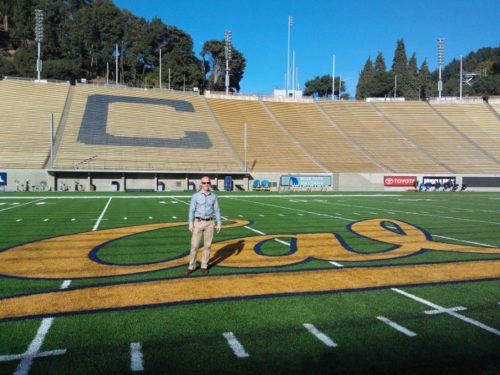 Many years ago I set a visual goal to capture the essence of my quest. I am on a journey to fill California Memorial Stadium with 63,000 people who I connected with and shared the concepts of the framework to help them improve their career.
Many years ago I set a visual goal to capture the essence of my quest. I am on a journey to fill California Memorial Stadium with 63,000 people who I connected with and shared the concepts of the framework to help them improve their career.
Over the stops on my quest, I have learned a few important things that keep me motivated.
First, I learn just as much or more from the people I meet and teach. It forces me to practice what I preach.
Second, the spirit of people helping people is contagious. It motivates people to do the same – all boats rise.
Third, I love my day job building software products and have found it exhilarating to position my profile inclusive of who I am in a broader context. It not only makes me unique, but it also takes off the mental pressure of thinking I need to do one or the other. You can do both if “why” is grounded in purpose.
As a father of 5 kids, the ultimate goal of my quest is to share this strategic framework and the insights I have gained so that I can save them precious time in the short life we have. They are my primary audience. I will culminate the quest with a book they can always remember me by.
Thanks for listening to why I do what I do! – James
